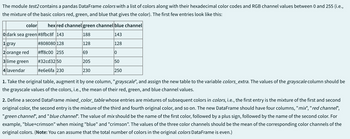
Database System Concepts
7th Edition
ISBN: 9780078022159
Author: Abraham Silberschatz Professor, Henry F. Korth, S. Sudarshan
Publisher: McGraw-Hill Education
expand_more
expand_more
format_list_bulleted
Question

Transcribed Image Text:The module test2 contains a pandas DataFrame colors with a list of colors along with their hexadecimal color codes and RGB channel values between 0 and 255 (i.e.,
the mixture of the basic colors red, green, and blue that gives the color). The first few entries look like this:
color
hex red channel green channel blue channel
O dark sea green #8fbc8f 143
188
143
1 gray
#808080 128
128
128
2 orange red
#ff8c00 255
69
0
3 lime green
4 lavendar
#32cd32 50
#e6e6fa 230
205
50
230
250
1. Take the original table, augment it by one column, "grayscale", and assign the new table to the variable colors_extra. The values of the grayscale column should be
the grayscale values of the colors, i.e., the mean of their red, green, and blue channel values.
2. Define a second DataFrame mixed_color_table whose entries are mixtures of subsequent colors in colors, i.e., the first entry is the mixture of the first and second
original color, the second entry is the mixture of the third and fourth original color, and so on. The new DataFrame should have four columns, "mix", "red channel",
"green channel", and "blue channel". The value of mix should be the name of the first color, followed by a plus sign, followed by the name of the second color. For
example, "blue+crimson" when mixing "blue" and "crimson". The values of the three color channels should be the mean of the corresponding color channels of the
original colors. (Note: You can assume that the total number of colors in the original colors DataFrame is even.)
Expert Solution
This question has been solved!
Explore an expertly crafted, step-by-step solution for a thorough understanding of key concepts.
Step by stepSolved in 2 steps

Knowledge Booster
Similar questions
- A palindrome is a word spelled the same way backwards and forwards. For example, Anna, radar, madam and racecar are all palindromes. Certain words can be turned into palindromes when the first letter is removed and added at the back, e.g. 'potato' will read the same backwards if we remove the 'p' and add it at the back, i.e. 'otatop' read backwards will still say 'potato'. Similarly, 'banana' when you remove the 'b' and add it at the back so that it becomes 'ananab' will still say 'banana' if you read it backwards. Write a program that reads a word into a C-string (a character array). The program should then determine whether the word would be a palindrome if we remove the first character and add it at the back of the word. Use only C-string functions and C-strings. Assume that we will not work with words longer than 20 characters. Hint: You may consider using the C-string function strrev () but it is not compulsory. Remember to plan your program!arrow_forwardWrite a program that lets the user enter a charge account number. The program should determine if the number is valid by checking for it in the following list: 5658845 4520125 7895122 8777541 8451277 1302850 8080152 4562555 5552012 5050552 7825877 7881200 1250255 1005231 6545231 3852085 7576651 4581002 Initialize a one-dimensional array with these values. Then use a simple linear search to locate the number entered by the user. If the user enters a number that is in the array, the program should display a message saying the number is valid. If the user enters a number not in the array, the program should display a message indicating it is invalid.arrow_forward
Recommended textbooks for you
 Database System ConceptsComputer ScienceISBN:9780078022159Author:Abraham Silberschatz Professor, Henry F. Korth, S. SudarshanPublisher:McGraw-Hill Education
Database System ConceptsComputer ScienceISBN:9780078022159Author:Abraham Silberschatz Professor, Henry F. Korth, S. SudarshanPublisher:McGraw-Hill Education Starting Out with Python (4th Edition)Computer ScienceISBN:9780134444321Author:Tony GaddisPublisher:PEARSON
Starting Out with Python (4th Edition)Computer ScienceISBN:9780134444321Author:Tony GaddisPublisher:PEARSON Digital Fundamentals (11th Edition)Computer ScienceISBN:9780132737968Author:Thomas L. FloydPublisher:PEARSON
Digital Fundamentals (11th Edition)Computer ScienceISBN:9780132737968Author:Thomas L. FloydPublisher:PEARSON C How to Program (8th Edition)Computer ScienceISBN:9780133976892Author:Paul J. Deitel, Harvey DeitelPublisher:PEARSON
C How to Program (8th Edition)Computer ScienceISBN:9780133976892Author:Paul J. Deitel, Harvey DeitelPublisher:PEARSON Database Systems: Design, Implementation, & Manag...Computer ScienceISBN:9781337627900Author:Carlos Coronel, Steven MorrisPublisher:Cengage Learning
Database Systems: Design, Implementation, & Manag...Computer ScienceISBN:9781337627900Author:Carlos Coronel, Steven MorrisPublisher:Cengage Learning Programmable Logic ControllersComputer ScienceISBN:9780073373843Author:Frank D. PetruzellaPublisher:McGraw-Hill Education
Programmable Logic ControllersComputer ScienceISBN:9780073373843Author:Frank D. PetruzellaPublisher:McGraw-Hill Education

Database System Concepts
Computer Science
ISBN:9780078022159
Author:Abraham Silberschatz Professor, Henry F. Korth, S. Sudarshan
Publisher:McGraw-Hill Education

Starting Out with Python (4th Edition)
Computer Science
ISBN:9780134444321
Author:Tony Gaddis
Publisher:PEARSON

Digital Fundamentals (11th Edition)
Computer Science
ISBN:9780132737968
Author:Thomas L. Floyd
Publisher:PEARSON

C How to Program (8th Edition)
Computer Science
ISBN:9780133976892
Author:Paul J. Deitel, Harvey Deitel
Publisher:PEARSON

Database Systems: Design, Implementation, & Manag...
Computer Science
ISBN:9781337627900
Author:Carlos Coronel, Steven Morris
Publisher:Cengage Learning

Programmable Logic Controllers
Computer Science
ISBN:9780073373843
Author:Frank D. Petruzella
Publisher:McGraw-Hill Education